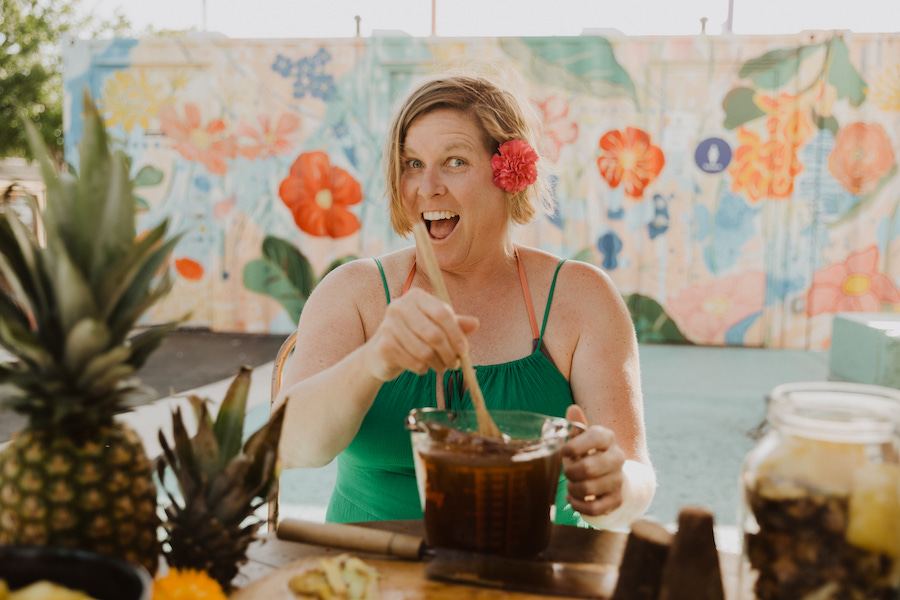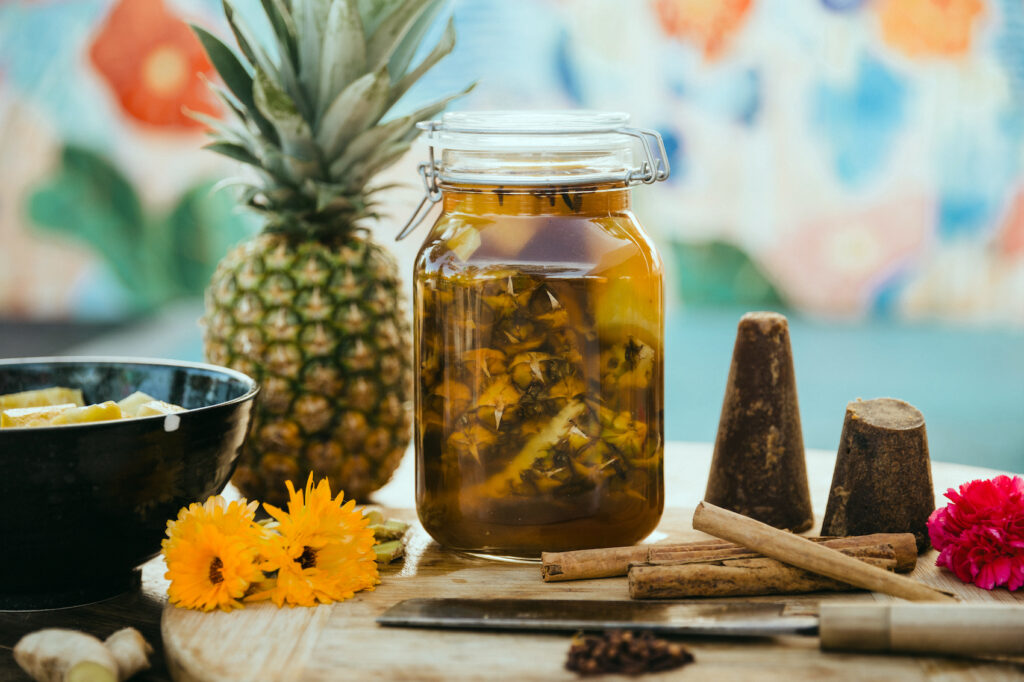Sheila Shupe Makes Tepache De Pina (Mexican Pineapple “Beer”)
Photos by Tammy Horton
I confess, dear reader, that deep in the middle of this past wet gray January, constantly clad in galoshes and a rain jacket that never quite dried out, I dreamed a lot about Mexico. Hot dry beaches and warm water, cobbled streets and al pastor tacos, all called deeply to my soul. I swung back and forth between gratitude for our much-needed rain and a primal craving to warm my body all the way through. Now that the sun’s out, I’m falling back in love with Sonoma County, tickled by the potential of warmer days to come. But dreams of that crystal blue water are never far from my heart, so I found a way to swirl a little bit of Mexico into our Sonoma County summer.
I discovered Tepache in a can at Oliver’s last summer, made by the company De La Calle out of Los Angeles. Always on the hunt for new germs to love, I saw this sparkly probiotic wonder with flavors like tamarind, mango chile, and ginger manzana, and I had to go for it. Unlike kombucha, which is typically made with green or black tea and uses a SCOBY (symbiotic culture of bacteria and yeast), Tepache is a simple ferment from pineapple rinds and sugar water, which makes it naturally caffeine-free. I fell in love pretty much instantly. And since my kids think it’s better than soda, now it’s a family staple. Once I figured out the recipe was about as easy as opening a can, I had to try my hand.
After a little digging, I found out that Tepache de Piña is a popular street drink in Mexico, sold chilled in plastic bags with a straw for easy travel. The flavors are as variable as the recipe is old, shifting from region to region. A typical mix of spices includes cinnamon, ginger, and cloves, but you could also add rosemary, cardamom, black pepper, or fresh fruit. It was originally made with corn by the Nahua people in pre-Columbian Mexico but evolved in the 1600s with the influx of trade from around the world that brought various fruits, spices and sugar for quick fermentation.
Sometimes called “pineapple beer,” tepache does have a small amount of alcohol (about 1%, twice that of kombucha), but it can’t get you drunk. I did experiment with it as a mixer in my white wine spritzers last summer, and it would work great with tequila or vodka, too. But the best way is in your cooler, on the river. It’s a great electrolyte booster, and of course it is packed with good germs for your gut.
Pineapple is loaded with vitamin C, and like any ferment, the process of culturing brings out a host of added nutrients, including manganese, thiamin and a range of other B vitamins. Pineapple also contains bromelain, an enzyme that can aid digestion and has anti-inflammatory properties.
Tepache is typically made with raw, unrefined sugar like piloncillo or jaggery, which have a lower glycemic index and contain minerals like iron and potassium in spades. Sugar is still sugar, so don’t fill your whole water bottle up with it, but a glass with dinner is the perfect way to integrate some healthy bacteria and ancient healing spices into your diet. Variations are endless, but my favorite is the classic Ayurvedic combo of a little ginger for anti-inflammation, cinnamon to boost your circulation and brain function, and clove for antioxidant power and liver health.
So this summer, add some ancient Mexico to your next homegrown Sonoma County barbecue, and think of me as it goes down—laying by the water, warmed all the way through, with no galoshes in sight!
Tepache de PiñA
Materials
Large glass jar or crock
Knife
Wooden spoon
Cheesecloth, paper towel or coffee filter
Rubber band or string
Ingredients
The rind and core of one organic pineapple
One cup of piloncillo, jaggery, muscovado or dark brown sugar
4-6 cups filtered water
Directions
• Peel and core pineapple and place rind and core in a glass jar.
• Add any additional spices or herbs.
• Place sugar in water and stir until mostly dissolved.
• Pour sugar water over pineapple rinds.
• Top with cheesecloth or paper towel and secure with rubber band.
• Let sit on the counter for 1-3 days, being sure to open the container once or twice a day to “burp” it, to prevent too much gas buildup.
• Check every 12 hours or so, and remove any white foam on the top with a clean wooden spoon.
• Transfer to a sealed container in the fridge when bubbly and slightly tangy.
Notes
Tepache will last about four days after you refrigerate it, and it should get more bubbly.
You can always add some carbonated water for more bubbles.
It will ferment faster in warmer temperatures, slower in cooler.
If you let it go for a week, it will turn alcoholic; for a month and you will have vinegar.
Be sure to use wood or glass when working with the tepache, as metal can be reactive to the acid in the fermentation.




